iPad 4 (Late 2012) Review
by Anand Lal Shimpi on December 6, 2012 4:40 PM ESTDisplay Analysis
The 4th gen iPad retains the same Retina Display as its predecessor. The 9.7-inch 2048 x 1536 display looks just as good as it did earlier this year. Brightness, black levels and contrast are all very good. The real advantage however is color accuracy thanks to Apple's factory calibration on all of its devices with an integrated display.
As with all of Apple's other Retina Displays, software support is made easy through integer scaling. The 2048 x 1536 resolution is an increase of 2x in both dimensions over the standard iPad/iPad mini resolution. App developers simply have to provide 2x scaled assets in order to make the most of the Retina Display. Deciding what image to load (standard res or 2x scaled) is handled automatically, the developer just needs to ensure that it's supplying both sets of images for the best user experience. Games can run either at the panel's native resolution, or run at a non-native offscreen resolution and simply scale up to the panel resolution if the title's performance requirements are too high (more on this later).
All first party apps and most of the 3rd party iPad apps I use on a regular basis are already Retina aware.
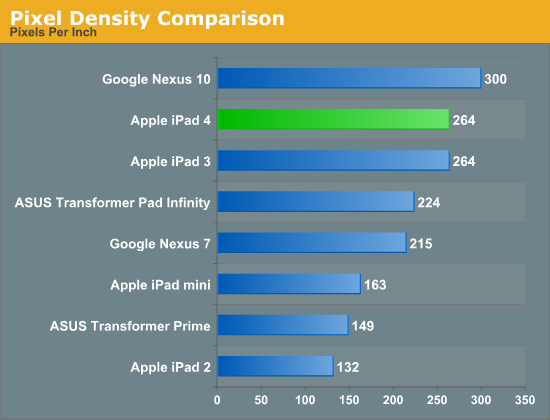
The big advantage the Retina Display offers over other iPads is a much better text reading experience. Individual letters look so much smoother:

I borrowed the paragraph shots below from our iPad mini review to give a better idea of how much of an improvement the Retina Display delivers when reading text:
Images also benefit from the Retina panel, but the advantage here ends up mostly being the accuracy of the display rather than the pixel density.

iPad mini (left) vs. iPad 4 (right)
With the exception of the 3rd generation iPad, only the Nexus 10 boasts any real competition to the iPad 4's display. I don't have a Nexus 10 on hand but Brian ran our suite of display tests on his review unit. Let's see how the two stack up in basic brightness and contrast measurements:
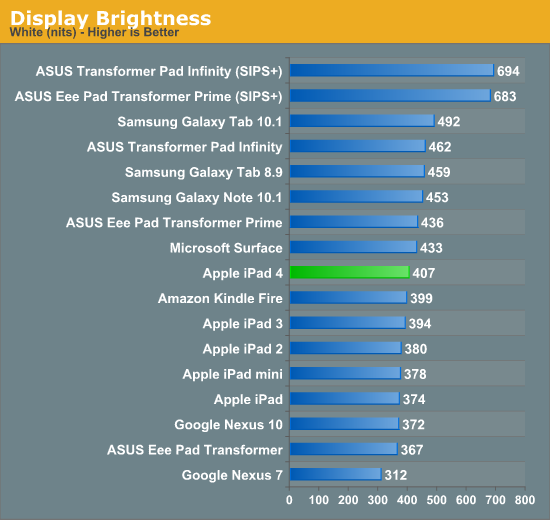
It's amazing to me that 400 nits on a nearly 10-inch display is simply middle of the pack now in modern tablets. This is just awesome. Look at any of our value notebook reviews and you'll find a bunch of displays that typically max out at sub 300 nits. It's no wonder that tablet sales are doing very well among consumers.
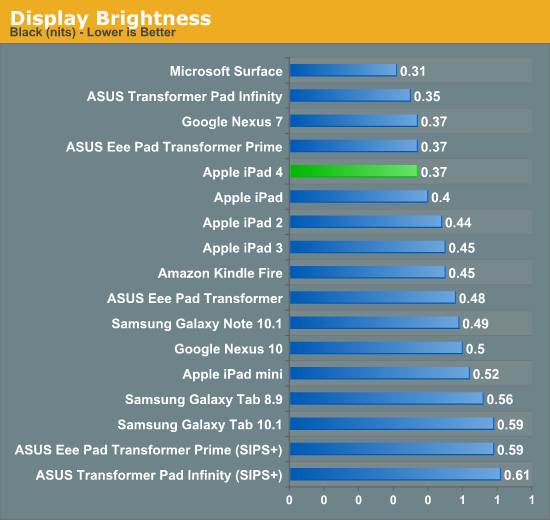
Black levels are good on the 4th generation iPad. Microsoft still holds the clear lead in black levels with its Surface RT, thanks to the tablet's bonded coverglass and display stack.
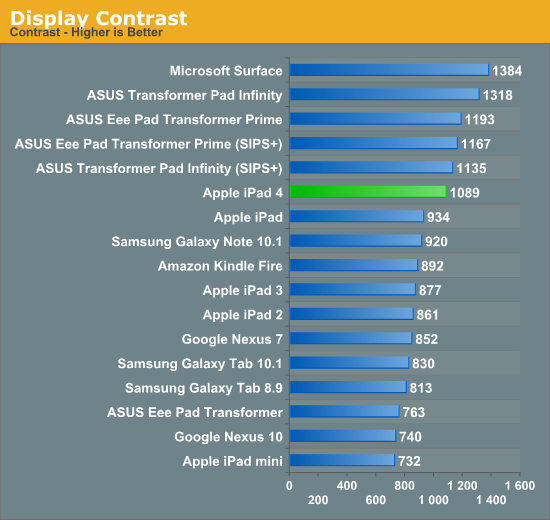
Overall contrast ratio is very good on the iPad 4. I measured a significant improvement over my iPad 3, although I suspect that has to do more with improvements to panel manufacturing than anything more deliberate.
Maintaining good brightness while pushing pixel density is only part of the equation. What made the iPad 3's display so great was that it shipped well calibrated from the factory. I assumed the same would be true for the 4th generation iPad, but I still needed to test to confirm.
To evaluate color accuracy I turned to our own Chris Heinonen's CalMAN smartphone/tablet workflow. We'll start off by looking at the calibrated white point for these tablets. What you're looking for here is a number close to 6500K:
Apple has been drifting north of 6503K for a while now. Variation in white point does seem to track well with individual panel makers in the iPad, so you may see numbers move around here depending on your luck of the draw. We've seen this in other iDevices in the past where whites will range from yellow to blue depending on what panel you end up with.
The next three charts look at accuracy represented as a difference between various source colors and what's reproduced on the display. The results are presented as average dE2000, with lower numbers being better.
First up is Grayscale performance, here we're looking at the accuracy of black, white and 19 shades of gray spread in between the two extremes:
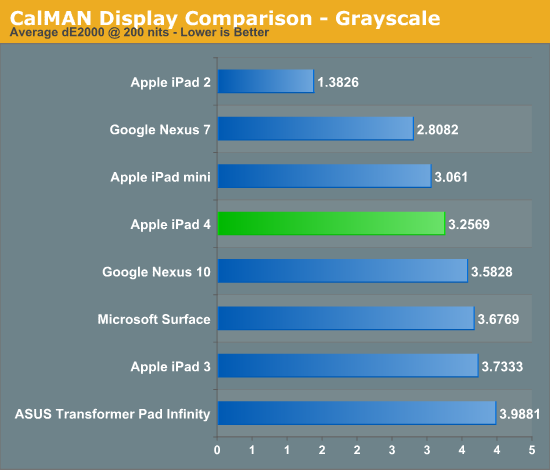
The 4th gen iPad does pretty well here, just edging out the Nexus 10 but losing to the iPad 2 and mini. Pretty much all of the tablets do a good job here at accurately reproducing grays.
First in our color accuracy tests is a saturation sweep. Here we're looking at 20%, 40%, 60%, 80% and 100% saturations of red, blue, green, magenta, yellow and cyan.
This is what you get with the iPad's pre-calibrated Retina Display: appreciably better color accuracy than any other tablet on the market today. I even measured an improvement in color accuracy compared to last year's iPad 3, however my iPad 3 was from the initial runs of production. I have noticed pretty significant variance between color accuracy between iPads. The results are always good, but some are definitely better than others.
Gamut CIE Chart
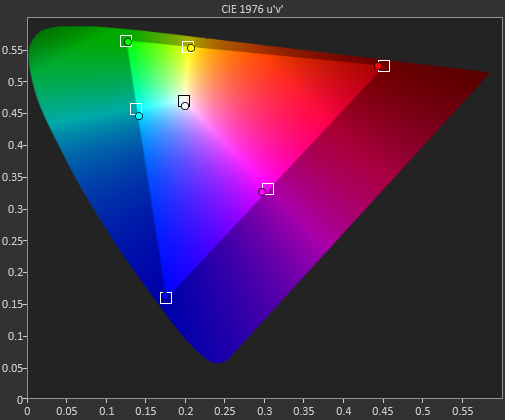
Saturation CIE Chart
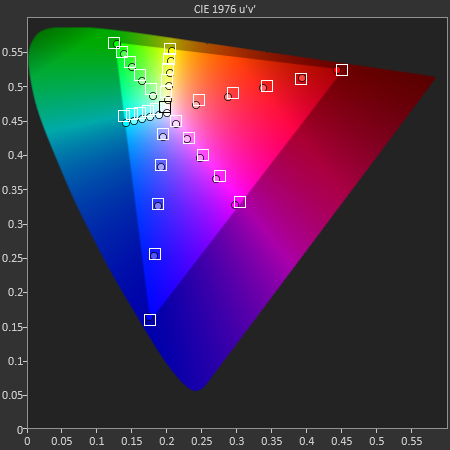
For our final accuracy test we're looking at the difference between a Gretag Macbeth colorchecker chart and the rendered swatches on these displays. Once again, lower numbers are better.
Many of the panels used here are actually good panels, the difference really boils down to calibration. Apple continues to dominate in terms of calibrated color accuracy. The 4th gen iPad's display remains the best in the industry from a color accuracy standpoint.
GMB Color Checker
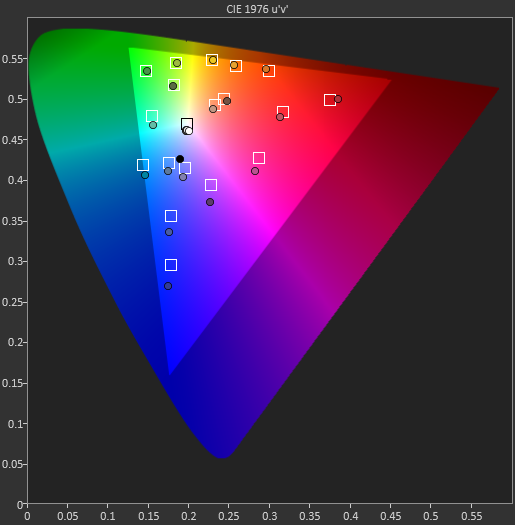





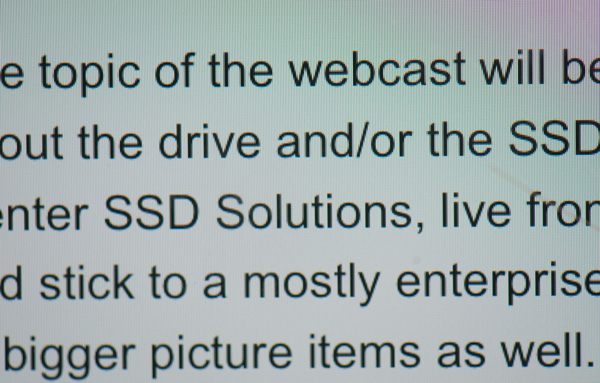
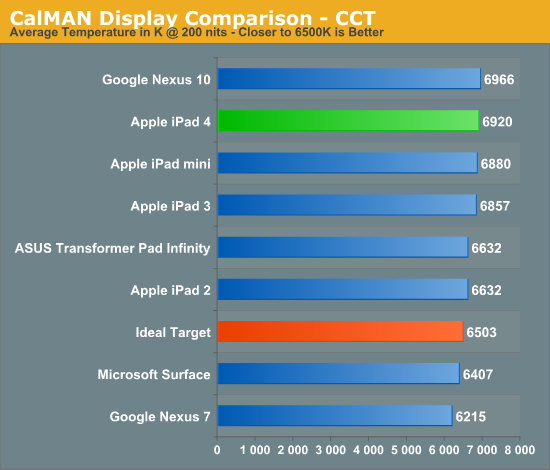
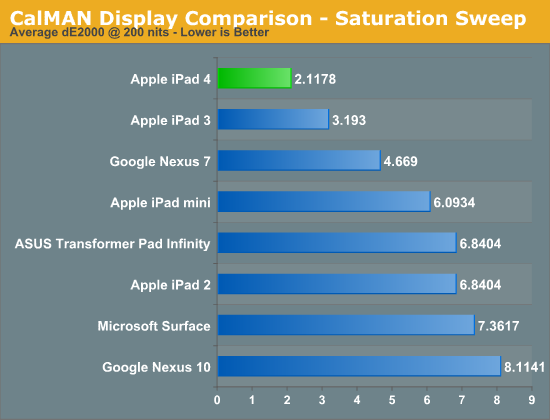
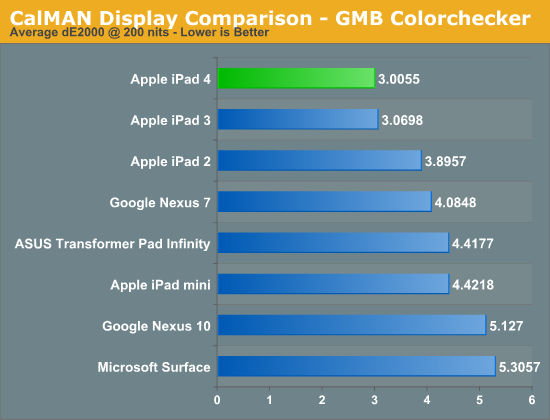








113 Comments
View All Comments
cheinonen - Thursday, December 6, 2012 - link
Color quality has always been a target, just not one that was possible for us to easily measure before. Now that we can, it's in almost every review. If that seems to favor Apple, that's only because other vendors refuse to care about it, and they aren't going to start caring until consumers understand and demand better.ltcommanderdata - Thursday, December 6, 2012 - link
It's not that pixel density is no longer important. It's that Apple has already satisfied people's needs for high pixel density. Most people already won't notice individual pixels on the iPad's 264 dpi display. So either Apple continues to improve pixel density for very little actual benefit, stops improving displays altogether, or they find another aspect of displays to improve. I think most people will be happy Apple choose the latter option and are improving color gamut and calibration.bplewis24 - Thursday, December 6, 2012 - link
I'm glad somebody else notices this. Taking a page straight out of Apple's Marketing dept.teiglin - Thursday, December 6, 2012 - link
Does Apple actually market their products this way? It's not like he's harping on it, but the S.S. Pixel Density set sail a year ago and all the high-end tablets are sufficient for most people (even the TF700, in my opinion--the steps from that to the iPad 4, then to the Nexus 10, are fairly incremental). Apple continues to differentiate its displays with proper calibration, and Anand is just pointing that out. As displays get better, it requires more attention to find the differences.The color accuracy on the Nexus 10 is objectively bad. I say this as someone who wants Google to step it up in this area--I have a Samsung tablet and my primary phone is HTC and have never owned an iPad or a Mac. Superior color accuracy isn't going to make me buy an iPad, but a dE over 8 on the Nexus 10 does make me think it's worth waiting for the generation of Google tablet.
bplewis24 - Thursday, December 6, 2012 - link
Check out their marketing materials and yes, even some of their commercials. When the coined the term "retina display" they immediately began publishing PPI measurements (and comparisons) in their marketing materials. The reason why this is significant is because other displays eventually caught up and surpassed in sheer resolution, but because the iPhone was smaller, the PPI measurement still stayed on top...even though, ironically, the benefits of such a high PPI and a much smaller display are harder to benefit from.cheinonen - Thursday, December 6, 2012 - link
The value of PPI has nothing to do with screen size, but distance relative to PPI. Just like an 84" 4K LCD has benefits if you sit 5' from it but no benefit if you are 25' from it compared to a same size 1080p display. The half-inch viewfinder of the camera I just bought has a 2.4 million dot OLED display. If that used the same PPI as a retina iPhone, with 3 dots per pixel, then that viewfinder would only have 0.2 million pixels and would certainly not be as sharp.However, as my eye is literally right next to that, a resolution way beyond 300 PPI is useful, despite the incredibly small size of the display. It's all about the distance relative to the PPI, not the size of the screen.
teiglin - Thursday, December 6, 2012 - link
I wasn't asking if they market PPI; I know that's the theme of the whole "retina" marketing. I was asking if they market the color accuracy and how their calibration is better than the competitors'. I've seem them mention the iPad's gamut (albeit briefly) but never its accuracy or calibration.EnzoFX - Thursday, December 6, 2012 - link
That's called avancement. The basis of technological progress. There Should always be something better to pursue. That is good for everyone. No matter how much your bias against Apple is.cheinonen - Thursday, December 6, 2012 - link
One more note on this. CalMAN 5 is used for measuring smartphones and tablets (and likely monitors in the future) since it supports measuring grayscale, gamut, saturations, and Gretag Macbeth charts, at any targets that we want, and with manual patterns instead of only internal pattern generators. Most solutions only allow for internal generators, which is why previous tablet and smartphone reviews (many of which were done well before Apple made a deal out of this) lack these charts as those programs don't run on an iOS or Android device.CalMAN 5 wasn't even released until September of this year, making most of these measurements impossible to do before then. So you can enjoy the conspiracy theories, but had these measurements been possible for me to do 18 months ago, I'd have done them 18 months ago.
JarredWalton - Friday, December 7, 2012 - link
On a related note, we've been discussing the importance of color accuracy on our LCD and laptop reviews for... oh, let's see... May of 2007.http://www.anandtech.com/show/2237
You'll notice that of all the laptop manufacturers, only Apple is consistently getting the display quality right (or at least, more right than others) for the MacBook Pro. And even that took a few years after my rant.